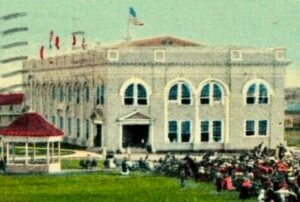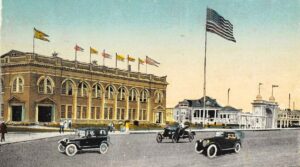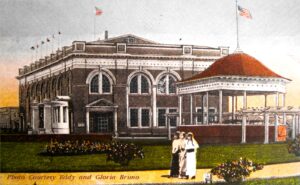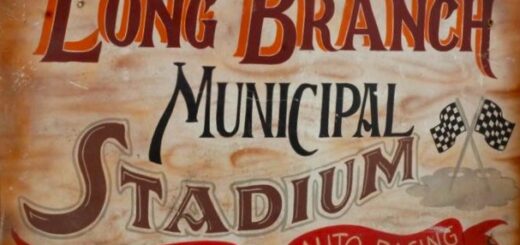Long Branch Casino: City Crowning
Start of a City …
The Long Branch Casino — majestically considered and placed where the city’s two greatest boulevards meet — had a “stormy time from the beginning.” Positioned on choice city land, the building would serve multiple purposes during its two decades of life, and yet, never really found a fit. Up and running by Spring 1907 at the corner of Ocean Avenue and Broadway, the Romanesque-design casino cost $70,000 — anchoring a 750-foot stretch along the Atlantic Ocean at Long Branch.
Built in conjunction with the development of Ocean Park — a project crowning Long Branch’s new designation as a city — the 10-acre oceanfront grounds had opened with a bang on Fourth of July 1906. The Long Branch Daily Record hailed the celebration as “the biggest day in the history of the resort.”
In April 1905 George V. Chasey won $50 in a city contest for the best casino concept. Clarence D. Wilson then designed the structure on the “best located and most accessible piece of property for public use,” according to the city council (who toured the new facility in January 1907). Richard Hughes built the wood-brick, two-story structure. In the beginning it had a 4,500-seat capacity — the “largest on the Jersey Coast.” In early 1900s parlance, a “casino” was a place for civic and entertainment gatherings; not a place to gamble. The first casino lease was granted to F.W. Falken of Asbury Park for $2,500 for a year in May 1907.
The open-air arena on the second floor was popular for boxing and wrestling matches in the 1910s and 1920s. It was leased by Daniel Maher (a future city mayor) who ran the events. The casino also served as a theater, skating rink, music and dance hall, and for basketball and baseball games, among other things. It also hosted many business conventions and was a meeting place for city organizations. Burned in a “roaring” early summer fire in June 1928, Mayor J. William Jones pronounced the casino a “failure.”
In truth, Long Branch has had several swings at properly developing the key Broadway-Ocean site over the past 200 years. Today it’s private property. The Ocean Place Resort & Spa holds the ground and has since July 1990 (developers William J. Maloney father and son paid $1.6 million for the land in October 1987).
Previously it was the Ocean Hotel — the nation’s largest in its Gilded Age heyday — until closing in 1902. The city acquired the property in 1905 for less than $75,000 and turned it into Ocean Park and later Garfield Memorial Park. The location also hosted two race tracks — for greyhounds and stock cars. The hotel trade for Long Branch had begun at the spot in 1832 with “Cooper’s House” which held 175 guests.

Super Shore Sights — Long Branch Casino, 1907. Architect Wilson was an Eatontown native who trained as a draftsman on many of the finer Allenhurst homes. Based on Broadway for 20 years, Wilson was the most acclaimed city architect early in the 20th Century. Upon his March 1922 passing, the Long Branch Daily Record hailed him as “a born architect.”

“City on a Bluff” — Ocean Avenue looking south just prior to casino construction, 1905. “No other coast resort is so favorably situated.” — Long Branch Daily Record, August 1906.

The Plan — Ocean Park sketch proposal, July 1906. Called “the beauty spot of the Jersey Shore” by Long Branch Daily Record.

Playing Field — The city oceanfront prior to casino construction, Long Branch Daily Record, September 1905.

Coming Up — New Long Branch Casino under construction. At center is the bandstand and right is the casino annex. A concert is in progress at Ocean Park.

Old Glory Waves — Long Branch Casino, 1909. The builder Hughes, a former city councilman, died in 1923.

Presidential Honors — Garfield Monument site plan for Ocean Park. Long Branch Daily Record, September 1907.

Star Power — Oliver Byron appearing at the Ocean Park Casino. Long Branch Daily Record, September 1908. Byron was sometimes call Long Branch’s “Summer Mayor.”
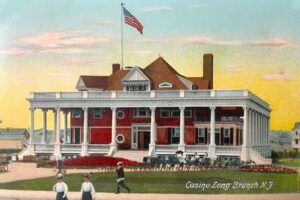
Next Door — Long Branch Casino Annex, 1920s. The building at Ocean Avenue and Broadway went through many identities in its lifetime. It’s believed to be an original section from the nation’s Centennial Exhibition held in Philadelphia in 1876.

Long Branch Casino Annex, 1905. The structure was moved to Long Branch in 1877 probably by Richard J. Dobbins. “One of the city’s last beach front landmarks” was torn down in May 1945.
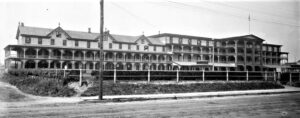
Here First — Ocean Hotel, 1904. Located at the corner of Broadway and Ocean Avenue, it started as “Cooper’s House” in 1832. The hotel continued to grow and change identities: it was the National House, the Continental Hotel and finally in 1872, the Ocean Hotel. The largest hotel in the nation at the time, it closed in 1902. The city acquired the property in 1905 and turned it into Ocean Park and later Garfield Memorial Park. Today, the Ocean Place Resort & Spa holds the grounds.
